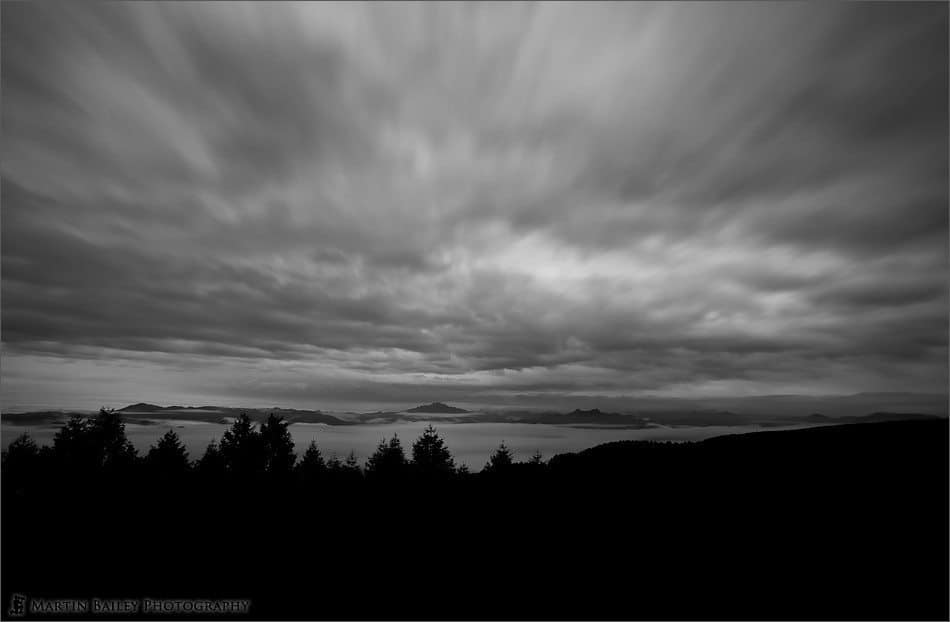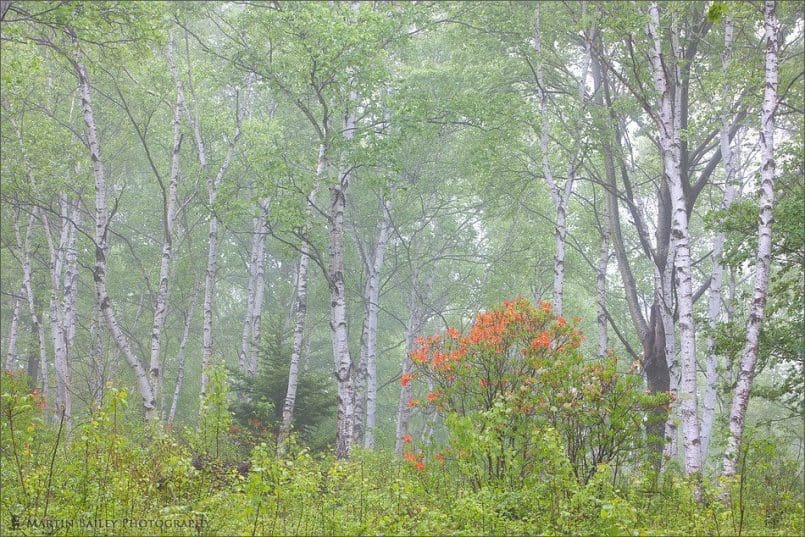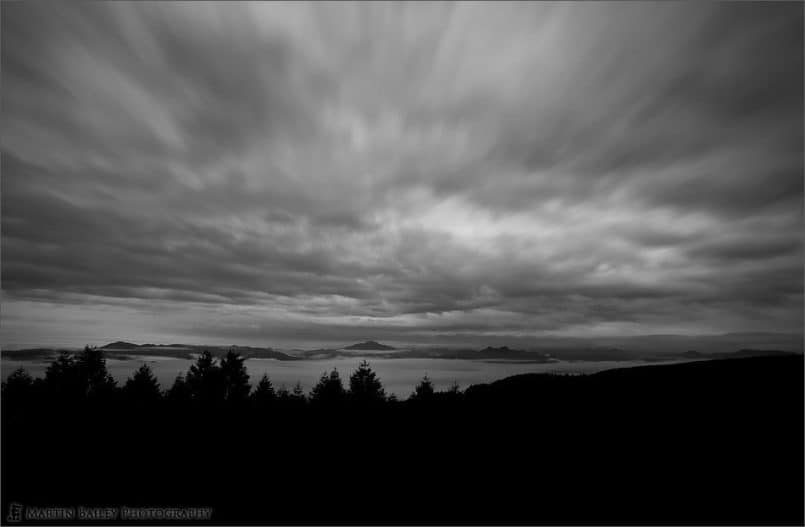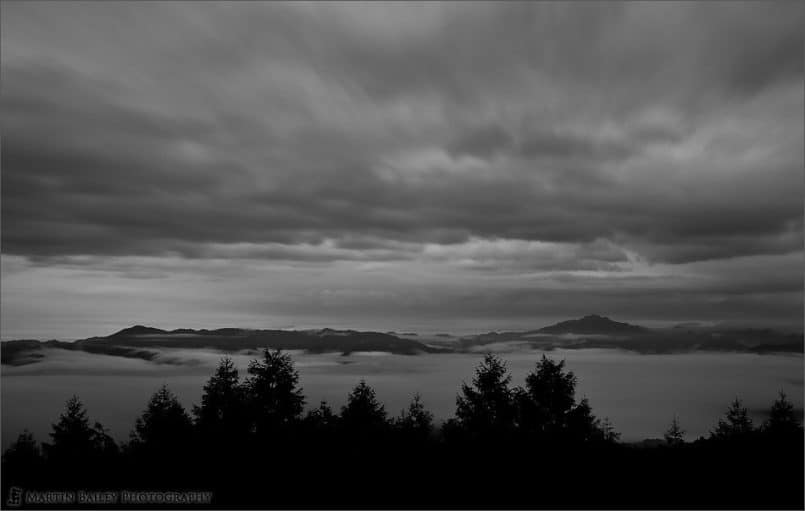As I mentioned last week, with the pressures of living in Tokyo and the need to breathe some fresh air got a hold of me and my other half, we took off to the Yachiho Highlands from May 31 for a few days. Today we start to share some of the images I brought back with me in a multipart series. I wasn’t going to spend the whole time photographing, as we took a steady drive over there on the Saturday, because I’d been up until 3AM finishing some work on the Friday night. We also started back at around lunch time on the third day, so the only time for photography was the last few hours of light on the 31st, granted, pretty much the whole day on the 1st of June, and then the morning of the 2nd. It was nice to have a relatively relaxed time though, although as usually I couldn’t resist getting up at the crack of dawn to see how things looked in that first hour or so of light. The main subjects we’ll look at are some wild Rhododendron trees surrounded by White Birch trees, which I love to photograph, and some waterfall shots from the afternoon of the 1st. I also was trying to get a lot of depth-of-field in many of the shots over this trip, which is exactly the opposite to most of my recent work, so I’ll talk about considerations when maximizing depth-of-field too.
As is so often the case, with my busy day job, and then fitting in my photography, which is definitely like having a second full time job for me, I didn’t actually book the hotel for the Saturday and Sunday nights until Friday night. I didn’t even book the days off from my day job until the Friday evening before I left the office at around 7PM, then I had to get two invoices off to a client for my Photography work, so I was really leaving all of this until the last minute. Having booked the hotel the invoices couldn’t wait either, so as I just mentioned in the intro, I was up until around 3:30AM on the Friday finishing up everything that had to be done. The idea was to have a relaxing weekend, though get lots of photography in too, so I didn’t push it by trying to get up in just a few hours to drive for three to four hours to the Nagano Prefecture, which is where we were heading. I was still pretty tired, having gone to be so late, but after having almost six hours of sleep, I got up at 9:30, got breakfast and got my gear together. We jumped into the car at just after noon and had a steady ride out of Tokyo and over to Nagano. Having stopped for a bight to eat on the way, we arrived in the area at around 5PM and started to scout out some photo opportunities.
I actually came here in mid-May, 2007, having seen a photograph of a wild Rhododendron tree in the White Birch trees that this area, Yachihokougen, is pretty famous for. The weather forecast had been rain for the Saturday, and then clear for the Sunday, which was perfect, as I wanted to photograph the Rhododendron trees in the mist if possible. When I came last year though, I couldn’t find any of the trees flowering, and when I asked a local, it seemed that the late snows had held the flowers back last year. This time, I was heading out here two weeks later than last year, because again, I’d heard there’d been some late snow, so I was hoping to found some of the trees flowering. The other problem was that I didn’t actually know which parts of the White Birch woods the Rhododendron trees were in, so it took a little bit of driving around, and even then, I couldn’t see anything obvious. The roads were empty though, so I figured leaving my car parked and having a walk into the woods wouldn’t hurt, and the White Birch has to be one of my favorite trees anyway, and because it was pretty misty with the low cloud, I figured that if nothing else, I’d be able to shoot some nice misty birch trees.
The funny thing was though, within literally 30 seconds of walking up the hill into the woods, I started to see the odd Rhododendron tree flowering in the mist, so I was starting to feel pretty happy about my choice of place to stop. Let’s take a look at the first image for today, which is number 1801. Here we can see the tree, with beautiful deep orange, almost red flowers, amongst almost all white birch trees. The mist was not that thick, so isn’t really registering very well here, but hopefully you’ll get a sense of the moment. It was raining pretty heavily too. At this point, my significant other was still enjoying the fresh mountain air, and happily holding a large umbrella over us both and my camera gear, set up on a tripod. We’ll look at maybe up to 20 images from this and the next episode, but I wanted to note that all but one of them were taken using a tripod. I’m a big believer in using a tripod to make the whole process of photography very well thought out and deliberate. Some of the images we’ll look at would have been possible without a tripod, but I am a proponent of using them whenever time allows, not just when the shutter speed or circumstances demand it. When I shot this particular photograph, I’d already been further up the slight incline, and shot the tree from a very low perspective, which is image number 1800. I won’t include that image today, for the sake of time, but I’ll put a link to all the images from this long weekend in the show-notes.
What I wanted to mention though is something that I’ve mentioned a number of times before, which is to always be aware of what is behind you. I spent maybe thirty minutes shooting this tree and the surrounding birch trees in various ways, and had started back down the hill to where the car was. Whenever I’m walking away from a scene though, to the great disappointment of my other half, I continue to look back, to make sure that I’m not missing something that would make a nice shot. I feel that when you are approaching a scene, you can be more interested in getting in and working the location, and are all excited about seeing what there is to offer, but there is no intimacy between you and the subject matter yet. You’re still exploring. Once that exploration is done though, and you decide what angles to shoot it from, what lenses and apertures and shutter speeds to use, you start to become more comfortable with the subject. Then when you feel you’ve exhausted all the possibilities, you pull the cord and start to walk away. The fact is though you usually haven’t really exhausted all the possibilities. You’ve probably really only scratched the surface, so I always keep an eye on a scene as I move away from it, in the hope that a face that I was not open to earlier presents itself to me now that I am more familiar with the subject or location.
Although I’d been shooting nice and wide with my 16-35mm F2.8 lens earlier, I used the 70-200mm F2.8 lens for this shot. I had moved away from the scene, but I was also moving down the hill, so we can see that my eye-level is almost ground level here, as we look across the forest floor. The focal length was 100mm so the telephoto has compacted the perspective a little, allowing the trees to almost be on top of each other, but still have a little bit of distance. I have placed the tree just off center towards the bottom right third, and ensured that the threes to the right and left are cut off in a non-distracting way. I used an aperture of F11 to ensure the whole scene was in focus, and that gave me a shutter speed of 6 seconds at ISO 100, so you can probably appreciate how dark it actually was at the end of this rainy afternoon in the mountains.
Shortly after shooting in this patch of trees, as the light was fading pretty fast now, we decided to head to the hotel for our first evening. As we rounded a corner on the mountain road heading down into the valley, both me and my other half gasped as we saw that the valley was totally enshrouded in cloud. We thought for a split second that we might have even been gazing at a huge lake, but there shouldn’t be a lake of this size in this area, unless my map reading skills had been totally off. There was a lake down there, but it should not have been that big. A few moments after starting to view the scene it became obvious that this was cloud, but still, it was sitting so perfectly in the valley, surrounded by the mountain on which we were standing and the mountains on the other side. I guess that’s what makes it a valley, right? Right there though, there was a lay by, so we pulled up and jumped out of the car. The light was fading fast, but it was a beautiful moment that I did not want to miss. We’ll look at two shots from here, and the first one is number 1802.
It isn’t as easy to see the clouds in the valley here, because I’ve shot this at 16mm, with my 16-35mm F2.8 lens. This first exposure lasted for 20 seconds at F11, still at ISO 100, so again, you will be able to appreciate how fast the light was dropping now. The long exposure has made the clouds close to me blur, a little like a lensbaby image, but this was not only expected, but an effect that I wanted. Of course, the clouds further away aren’t moving as much in relation to my position, so they aren’t blurred. They are obviously moving at the same speed, but they are coming towards me, as opposed to moving over me. I converted to black and white in Lightroom, and dragged the blacks down a little to emphasize the heavy sky and also bring out the black of the mountains on the other side of the valley. They were a little greyer in the original. Again, I decreased the saturation of the all the colors to zero, then adjusted the balance between each color channel with the Luminosity. I think I heard Derrick Story talk about this tip that he’d picked up from someone else on his Podcast “The Digital Story”. If you don’t listen to that Podcast actually you should. Some of it can be a little basic, but there’re often a few gems to pick up for just about any level of photographer and Derrick has a very entertaining way of putting his message across. Anyway, converting to black and white in this way prevents the shadows from going all grainy and muddy, so try it yourself next time you convert something to black and white.
I said that I would also talk about getting lots of Depth-of-Field in this Episode too, which I’ll get into more shortly. For now, I wanted to say that if I was not too worried about calculating the hyper-focal distance for my shots over these few days, because I wasn’t really looking at getting a sweeping landscape in with the whole scene in focus from front to back, in the usual sense. If you want to learn what hyper-focal distance is and how to use it to achieve what we call pan-focus, then you might want to listen to episode 65 that I did, called Understanding Hyper-focal Distance. You might be wondering why I didn’t want to use it for this shot, but just look at how far away from me that line of trees is and think about the focal length I’m shooting at. At 16mm, basically the lens goes hyper-focal at 3.6m or 12.5ft, even when wide open at F2.8, so if I focused at 3.6m, everything from 2m to infinity will be in focus. Those trees were a good 50 meters in front of me, and I knew that everything this side of the trees was going to be black anyway, so I could have shot wide open and focused on the trees and I would have been fine. Remember though that I wanted a slow shutter speed to emphasis that heavy sky, so I closed the aperture down to F11, which gave me a nice long 20 second shutter speed. At F11 by the way, the hyper-focal distance is 1m, but we already know that that is irrelevant for this particular shot.
Let’s take a look at another image which is literally the next exposure I made, which is image number 1803. Here what I’ve done is zoomed in from 16mm to 35mm literally going from one extreme of the lenses focal range to the other. I changed the exposure time from 20 to 30 seconds as the light died, and wanted really here to give us a feel for the clouds, that I could see rolling over the edge of the smaller mountains in the distance to the left. You also get a better feel for the sea of clouds in the valley here, as well as the distant mountains and that wonderful dramatic sky. For the black and white conversion, I simply synced the settings from the previous conversion. No need to reinvent the wheel, as I’d just spent some time figuring out the best place for the Luminance sliders for the previous image. Here we also see more detail in the foreground trees, which I’ve focused on, but again, the entire scene is sharp, because the hyper-focal distance even at 35mm is 4.6m, or 15ft. I’d have still been OK at F2.8 but that would start to worry me a little. I wasn’t using my DOF utility on my cell phone by the way, and I’m using Barnack to lookup the exact numbers for the sake of the Podcast. But the more you use hyper-focal distance the more you get a feel for where you need to be with your lenses, so it isn’t always necessary. Especially here, I just knew that I’d be way OK if I focused on those trees and let the physics of the lens do the rest.
This particular time was actually incredibly special. Once I’d gotten the camera set up, and was making a few exposures, and just standing there listening to the sounds of the forest. The birds were just about all asleep now, though there was still a little bit of chirping going on as they settled in to roost, but every so often we could hear the cries of what sounded like the dominant male in a pack of macaque monkeys, not far from where we were. As you look at this image, the area to the right, is actually a very deeply wooded area of deciduous trees, and seems to be home to a fair number of macaques. We’d also startled a pair of deer moments earlier with my headlights, and was feeling pretty close to nature, even though we were little a few paces from the car at this point. Without getting all Mills and Boon on you, I had put my arm out and pulled my significant other over, and with my arm around her shoulder just stared out across this magnificent vista while listening to the cries of the macaque and birds settling down for the night. These literally final moments of the day were truly magical, almost spiritual. The hair on the back of my head stood up as I waited for my exposure to end. It was this, the fresh air, the beauty of the land and nature, and the sounds of the wilderness that had brought us some three hours northwest of Tokyo on this murky yet beautiful Saturday afternoon.
Show Notes
Check out TinEye here: http://tineye.com/
Here’s a link to Mikkel Stegmann’s Barnack utility that I reference so much for depth-of-field and hyperfocal distances, and mentioned in the Podcast: http://www.stegmann.dk/mikkel/barnack/
The music in this episode is from the PodShow Podsafe Music Network at http://music.podshow.com/
Subscribe in iTunes for Enhanced Podcasts delivered automatically to your computer.
Download this Podcast in MP3 format (Audio Only).
Download this Podcast in Enhanced Podcast M4A format. This requires Apple iTunes or Quicktime to view/listen.






0 Comments